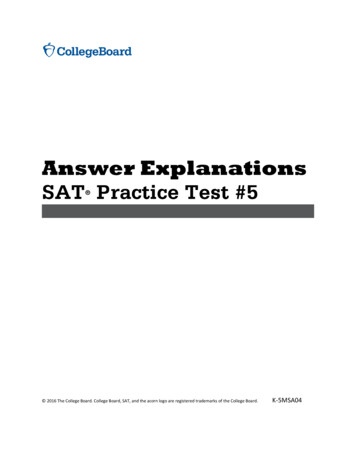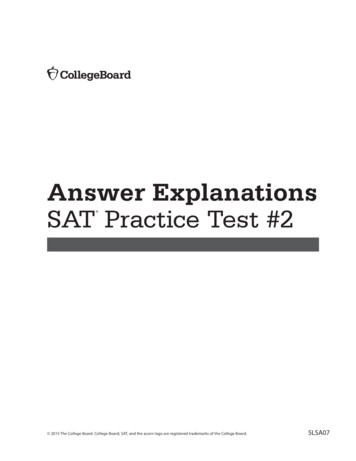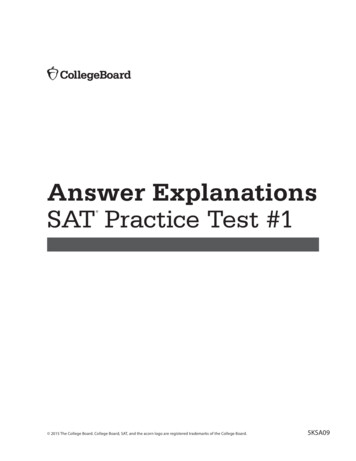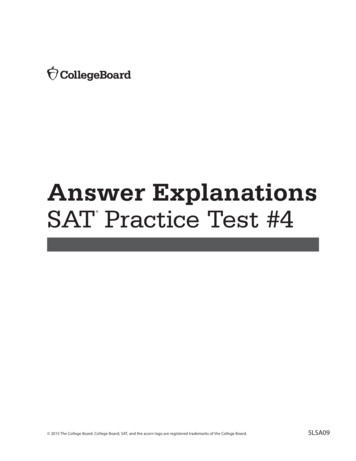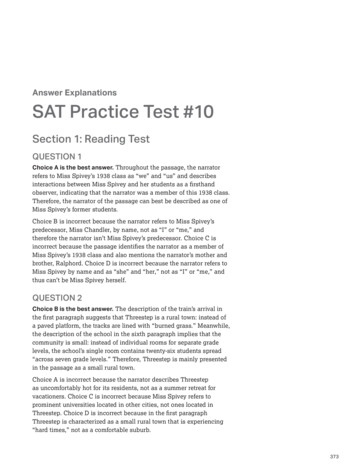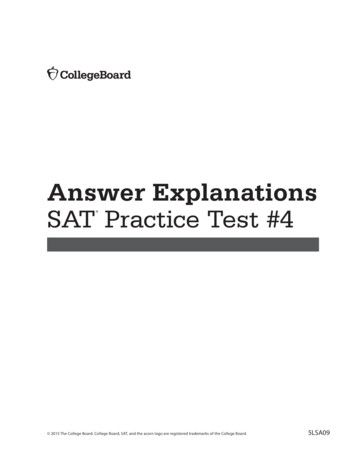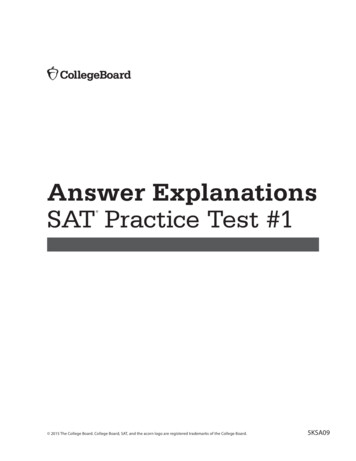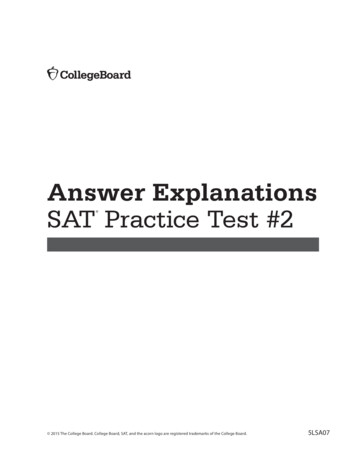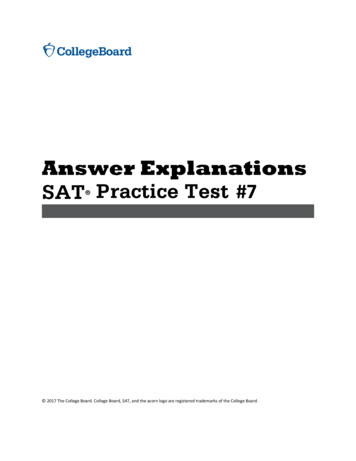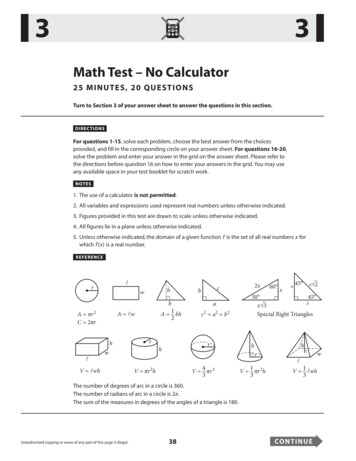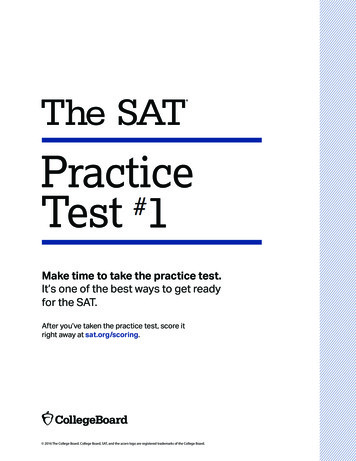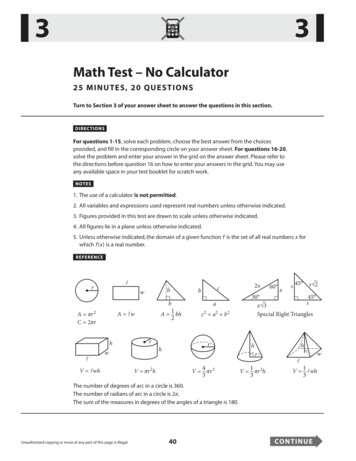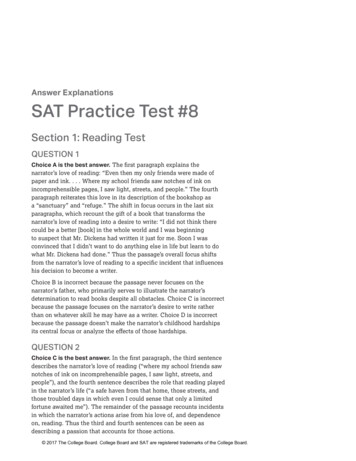
Transcription
Answer ExplanationsSAT Practice Test #8Section 1: Reading TestQUESTION 1Choice A is the best answer. The first paragraph explains thenarrator’s love of reading: “Even then my only friends were made ofpaper and ink. . . . Where my school friends saw notches of ink onincomprehensible pages, I saw light, streets, and people.” The fourthparagraph reiterates this love in its description of the bookshop asa “sanctuary” and “refuge.” The shift in focus occurs in the last sixparagraphs, which recount the gift of a book that transforms thenarrator’s love of reading into a desire to write: “I did not think therecould be a better [book] in the whole world and I was beginningto suspect that Mr. Dickens had written it just for me. Soon I wasconvinced that I didn’t want to do anything else in life but learn to dowhat Mr. Dickens had done.” Thus the passage’s overall focus shiftsfrom the narrator’s love of reading to a specific incident that influenceshis decision to become a writer.Choice B is incorrect because the passage never focuses on thenarrator’s father, who primarily serves to illustrate the narrator’sdetermination to read books despite all obstacles. Choice C is incorrectbecause the passage focuses on the narrator’s desire to write ratherthan on whatever skill he may have as a writer. Choice D is incorrectbecause the passage doesn’t make the narrator’s childhood hardshipsits central focus or analyze the effects of those hardships.QUESTION 2Choice C is the best answer. In the first paragraph, the third sentencedescribes the narrator’s love of reading (“where my school friends sawnotches of ink on incomprehensible pages, I saw light, streets, andpeople”), and the fourth sentence describes the role that reading playedin the narrator’s life (“a safe haven from that home, those streets, andthose troubled days in which even I could sense that only a limitedfortune awaited me”). The remainder of the passage recounts incidentsin which the narrator’s actions arise from his love of, and dependenceon, reading. Thus the third and fourth sentences can be seen asdescribing a passion that accounts for those actions. 2017 The College Board. College Board and SAT are registered trademarks of the College Board.
Choice A is incorrect because although the narrator’s “school friends”are mentioned in passing in the third sentence, they aren’t introducedas proper characters and make no further appearance in the passage.Choice B is incorrect because the passage doesn’t list the difficultconditions of the narrator’s childhood until after these sentences.Choice D is incorrect because the narrator’s aspirations aren’tdiscussed until the last paragraph of the passage.QUESTION 3Choice C is the best answer. The tenth paragraph shows that uponreturning home, the narrator hides the gift (the “new friend”) thatSempere had given him: “That afternoon I took my new friend home,hidden under my clothes so that my father wouldn’t see it.” It can beinferred from this sentence that the narrator’s concern arises from anawareness that his father would disapprove of the gift.Choice A is incorrect because although the passage discusses thefather’s hostility toward the narrator’s love of reading, there is noindication that the father is not affectionate to the narrator moregenerally; indeed, the third paragraph depicts the father’s generositytoward the narrator. Choice B is incorrect because the father’sgenerosity toward the narrator, as depicted in the third paragraph,clearly shows that the father encourages unnecessary purchases ofsuch things as candy. Choice D is incorrect because although the firstparagraph shows that the father is hostile toward books in general,there is no indication in the passage that Dickens or any other authoris a specific object of the father’s disdain.QUESTION 4Choice D is the best answer. The previous question asks whichstatement about the narrator’s father would the narrator most likely agreewith. The answer, that his father wouldn’t have approved of Sempere’s giftto the narrator, is best supported in the tenth paragraph: “That afternoonI took my new friend home, hidden under my clothes so that my fatherwouldn’t see it.” It can be inferred from this sentence that the narrator isaware of his father’s likely disapproval of the gift (the “new friend”).Choices A, B, and C are incorrect because the cited lines don’t supportthe answer to the previous question. Instead, they show the fathergiving his own gift to the narrator (choice A) and illustrate how thenarrator was treated when in Sempere’s bookshop (choices B and C).QUESTION 5Choice A is the best answer. The last paragraph makes clear thenarrator’s enthusiasm for Charles Dickens’s Great Expectations, andit can be inferred from the last sentence of this paragraph that thisenthusiasm motivated the narrator to aspire to a career as a writer:“Soon I was convinced that I didn’t want to do anything else in life butlearn to do what Mr. Dickens had done.”
Answer Explanations SAT Practice Test #8Choice B is incorrect because the passage doesn’t discuss gifts thenarrator has received in the past; although the father sometimes gavethe narrator money to buy sweets and snacks, these weren’t gifts sincethe narrator made the purchases himself. Choice C is incorrect becausealthough it is clear from the passage that Sempere was kind and evenindulgent to the narrator, there is no suggestion that this treatmentwas inspired by respect for the narrator. Choice D is incorrect becausethere is no suggestion that the narrator took Sempere’s figurativedesignation of Dickens as a “lifelong friend” in the ninth paragraph tobe a literal statement.QUESTION 6Choice D is the best answer. The previous question asks why thenarrator considers Great Expectations to be the greatest gift he everreceived. The answer, that the book convinced him to become a writer,is best supported by the last sentence of the last paragraph: “Soon Iwas convinced that I didn’t want to do anything else in life but learn todo what Mr. Dickens had done.”Choices A, B, and C are incorrect because the cited lines don’tsupport the answer to the previous question. Instead, they explainthe narrator’s interactions with the bookseller (choice A), describe thebook’s physical condition (choice B), and indicate the narrator’s initial,erroneous assumption that Sempere knew Charles Dickens personally(choice C).QUESTION 7Choice D is the best answer. In the fourth paragraph, the narratorexplains that although Sempere normally didn’t charge him for books,he still left Sempere a few coins as payment: “It was only smallchange—if I’d had to buy a book with that pittance, I would probablyhave been able to afford only a booklet of cigarette papers.” These linessignal the narrator’s awareness that he was paying less for the booksthan they were worth.Choice A is incorrect because the passage states that Sempere didn’texpect or want the narrator to pay: “He hardly ever allowed me to payfor the books.” Choice B is incorrect because the fourth paragraphmakes clear that even if Sempere didn’t want the narrator's money, thenarrator would still “leave the coins I’d managed to collect.” Choice Cis incorrect because the third paragraph states that the money withwhich the narrator paid Sempere was originally given to the narratorby his father.QUESTION 8Choice B is the best answer. In the fourth paragraph, the narratordescribes his reluctance to leave Sempere’s bookshop: “When it wastime for me to leave, I would do so dragging my feet, a weight on mysoul.” In this context, “weight” most nearly means burden.
Choices A, C, and D are incorrect because in the context of the narratorhaving to do something he doesn’t want to, a “weight” he had to carrymost nearly means a burden, not a bulk (choice A), force (choice C), orclout (choice D).QUESTION 9Choice C is the best answer. When, in the eighth paragraph, thenarrator asks Sempere if the author Charles Dickens is a friend of his,Sempere replies, in the ninth paragraph, that Dickens is a “lifelongfriend. And from now on, he’s your friend too.” Sempere designatedDickens a “friend” of both himself and the narrator, who had neverheard of the author before. This signals that the use of “friend”in these lines is figurative and emphasizes Sempere’s emotionalconnection to Dickens and, more generally, to reading. It alsosignals Sempere’s hope that the narrator will come to have a similarconnection to Dickens.Choices A, B, and D are incorrect because the word “friend” is used inthese lines to emphasize Sempere’s connection to reading, rather thanhis connection to the narrator (choice A), the narrator’s relationshipsor home life (choice B), or the narrator’s emotional state or decisionmaking (choice D).QUESTION 10Choice B is the best answer. In the ninth paragraph, Sempere describesthe author Charles Dickens to the narrator: “A lifelong friend. And fromnow on, he’s your friend too.” As the reader can reasonably assume thatSempere doesn’t actually know Dickens, this description can be read assignaling Sempere as an avid admirer of Dickens’s work.Choice A is incorrect because the passage describes Sempere as abookseller, not a writer. Choice C is incorrect because although thepassage implies Sempere feels an emotional connection to Dickens, itdoesn’t suggest that this connection arises from any similarity betweenSempere’s life and that of Dickens. Choice D is incorrect becauseeven if the passage implies that Sempere admires Dickens’s work,Sempere’s admiration isn’t discussed in relation to that felt by otherreaders of Dickens, nor is Sempere shown to compare himself to othersuch readers.QUESTION 11Choice B is the best answer. The first paragraph describes thewidespread practice of not reporting null results, or results in whichresearchers fail to see an effect that should be detectable. The secondthrough sixth paragraphs discuss a study that examined how scientistshave dealt with null results. The seventh and eighth paragraphsdiscuss the negative consequences that null results pose for futureresearch and the possible creation of a registry for all data produced byresearch studies, reported and unreported alike, as a remedy for those
Answer Explanations SAT Practice Test #8consequences. Therefore, the purpose of the passage as a whole is toexplain a common practice in the reporting of research studies andsummarize a study that provides support for a change to that practice.Choice A is incorrect because the passage doesn’t dispute a widelyheld belief about the publication of social science research; rather, itsuggests a solution to deal with a long-debated problem. Choice C isincorrect because while the passage hints at possible shortcomings inresearch trials, it doesn’t describe them in detail; because it addressesother kinds of research besides medical trials; and because it doesn’tcall for a government database, specifically. Choice D is incorrectbecause the passage calls for changes to the reporting of researchresults, rather than to research methodology itself, and because itdoesn’t address the publishers of research at all.QUESTION 12Choice D is the best answer. The second paragraph states that “TESSallows scientists to order up Internet-based surveys.” In the contextof the service that the TESS program provides to scientists, “allows”most nearly means enables.Choices A, B, and C are incorrect because in the context of thepassage’s discussion of TESS, “allows” most nearly means enables,not admits (choice A), tolerates (choice B), or grants (choice C).QUESTION 13Choice D is the best answer. The fifth paragraph of the passageaddresses the “statistical strength” of certain scientific findings. In thiscontext, “strength” most nearly means significance, or importance.Choices A, B, and C are incorrect because in the context of thestatistical importance of scientific findings, “strength” most nearlymeans significance, not attribution (choice A), exertion (choice B), ortoughness (choice C).QUESTION 14Choice A is the best answer. The seventh paragraph discusses thenegative consequences of not publishing null results, emphasizingthat “worse, if researchers publish significant results from similarexperiments in the future, they could look stronger than they shouldbecause the earlier null studies are ignored.” In other words, failing todocument null results means that the results of later, related studieswill not be as accurate as they appear.Choices B, C, and D are incorrect because the passage does notindicate that failing to document null results can cause promisingareas of research to be overlooked (choice B), cause errors in datacollection practices that lead to null results being overlooked(choice C), or lessen bias against null results (choice D).
QUESTION 15Choice D is the best answer. The previous question asks what thepassage indicates could result from failing to document null results.The answer, that the results of future studies will be misleading,is best supported in the seventh paragraph: “Worse, if researcherspublish significant results from similar experiments in the future, theycould look stronger than they should because the earlier null studiesare ignored.”Choices A, B, and C are incorrect because the cited lines don’tsupport the answer to the previous question. Instead, choice Asuggests how the findings of a study about null results mayaffect existing beliefs about such results; choice B explainshow infrequently null results had been written up, according toMalhotra’s study; and choice C illustrates a problem resulting fromthe failure to document null results, but one that is unrelated to thefact that this documentation failure may make the results of future,related studies appear more valid than they are.QUESTION 16Choice B is the best answer. The last two sentences of the seventhparagraph identify a particular research scenario that Malhotrauncovered in his study: “Even more troubling to Malhotra was the factthat two
Answer Explanations. SAT Practice Test #8. Section 1: Reading Test. QUESTION 1. Choice A is the best answer. The first paragraph explains the narrator’s love of reading: “Even then my only friends were made of paper and ink. . . . Where my school friends saw notches of ink on incomprehensible pages, I saw light, streets, and people.” The fourth paragraph reiterates this love in its .
